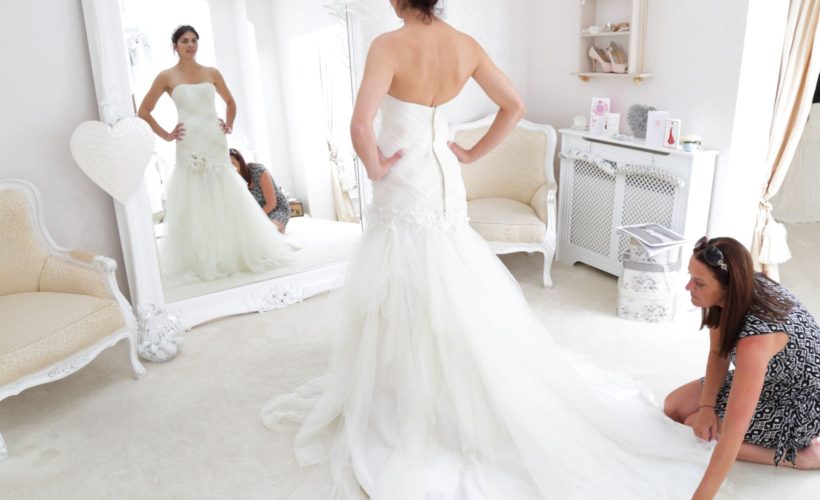As a bride to be, Mary Thornally was dreading the experience of shopping for a wedding dress and, ultimately, paying an exorbitant price.
“My sister and I had planned to go look around at stores, but then the whole thought of it was really daunting to me,” said Thornally, a stay-at-home mom and San Francisco Bay Area resident, feeling “overwhelmed” by the thought of trying on dresses in person and making a decision on the spot.
With gowns and alterations averaging $1,509 per bride in 2017, according to wedding site TheKnot.com, Thornally said she needed a “practical” alternative because she is “drowning in student loan debt” and trying to avoid unnecessary expenses. She worked to keep costs down, for instance, by buying her bouquet at Safeway and having her sister serve as photographer.
Read more from USA Today:
Alfred Angel closes, files for bankruptcy, panicking brides
Destination weddings: The good, the bad and its effect on the budget
Planning a wedding? Bucking tradition can help you save big
She also decided to buy her wedding dress on the internet, joining a wave of brides who are shopping online for a product long dominated by specialty stores and boutique shops. Online retail, social media, personalized fashion trends, alternative choices and declining marriage rates collectively pose a serious threat to brick-and-mortar wedding retailers.
Thornally ended up buying her dress for her late-August wedding for about $180 and getting it tailored for $160. And she was thrilled with the quality.
“All in all, I think $340 is incredibly cheap,” she said.
Wedding retailers get divorced
As more customers like Thornally embrace online alternatives, average gown prices are falling, and physical stores are struggling to adapt:
• David’s Bridal, once known for the tight grip it held on the wedding business, is facing serious financial challenges. David’s Bridal still sells about one in three U.S. wedding dresses through its more than 300 stores and website, with estimated annual retail revenue of $791 million, according to market research firm IBISWorld.
But the company recently hired restructuring adviser Evercore to evaluate its options amid what S&P Global Ratings called “weak operating performance and weak liquidity.”
• The Gap cut its Weddington Way brand, which primarily sold bridesmaid dresses at Banana Republic locations, in 2017.
• J. Crew ended its bridal-wear line in fall 2016.
• Many mom-and-pop shops and other wedding retailers have gone out of business, including Alfred Angelo Bridal, which abruptly closed its about 60 stores in a 2017 liquidation that left many brides scrambling to get dresses.
Another problem for traditional wedding dress sellers: Renting a gown is now just as easy as buying – and less expensive.
To be sure, wedding retailers often make money on other products, such as high school prom dresses or wedding accessories. But they live and die on the bridal gown business, which makes up about 43 percent of the wedding retail industry’s revenue, according to IBISWorld.
The trend of Americans waiting longer to get married, or deciding not to altogether, isn’t helping. The number of new marriages per 1,000 Americans was 6.9 in 2016, down from 8.2 in 2000, representing decline of about 16 percent in the wedding rate, according to the U.S. government.
With upstart online retailers offering lower prices and customized dresses, brides aren’t abandoning traditional gowns altogether. But the days of wedding dresses coming in a limited number of shapes, sizes and prices from a select group of stores are coming to an end.
That might be good news for consumers seeking deals and choices. The average price paid for a wedding dress fell 3.5 percent from 2016 to 2017, according to TheKnot.
But physical retailers often can’t afford to stock a wide mix of choices yet must continue paying steep real estate costs and invest in costly digital systems.
“The number of weddings has gone down over the last few years, but then there’s also a trend of brides spending less on their wedding gowns,” said Mathew Christy, S&P Global Ratings analyst who studies David’s Bridal. “A shopper can go online and do a price comparison between a number of different, similar adjacent products.”
David’s Bridal left at the altar
For years, David’s Bridal has been the giant in the budget wedding business. The company’s wedding dresses average $599, according to IBISWorld.
But the company, which was acquired in 2012 for more than $1 billion by private equity firm Clayton, Dubilier & Rice, has an “unsustainable” amount of debt and not enough money coming in to pay for it, Christy said. The company is turning a profit before interest, taxes and debt payments, but is facing a $520 million term loan due in October 2019.
Ratings agency Moody’s ranked David’s Bridal among retailers that could default on their debts or file for bankruptcy protection in 2018.
he retailer plans to close nine stores in 2018 for a total of 309 remaining locations by the end of the year. The company’s digital sales have improved but are still “lagging behind other competitors,” according to S&P.
David’s Bridal said in a statement to USA TODAY that “our financial outlook is strong and we have ample liquidity to meet our key business objectives today and in the future.”
“The company continues to work with its long-time external legal counsel and has hired an external financial adviser to evaluate a number of options to strengthen our balance sheet so we can increase our financial flexibility and further invest in our business,” David’s Bridal said.
The company said it is “laser-focused on operational excellence” and “providing a great experience for our customer base.”
To be sure, most wedding dresses are still sold in person – about 95 percent, according to online custom-wedding seller Anomalie. That could ultimately benefit David’s Bridal if it can do a better job of seamlessly integrating its stores with its digital experience.
Alternatives sprout
But the pursuit of deals, customized dresses and convenience is fueling an online surge that many physical retailers aren’t well equipped to counteract – much like department stores Sears and J.C. Penney have struggled to adapt to the digital age.
The internet, including social media outlets such as Pinterest, has usurped other sources as the primary method of wedding planning. About 92 percent used smartphones to plan their wedding in 2017, up from 42 percent in 2014, according to TheKnot.
Former Apple supply chain guru Leslie Voorhees co-founded online custom-wedding dress seller Anomalie in 2016 after experiencing a “pretty painful” in-person dress-shopping experience and “outrageous prices” when she was engaged to her now-husband and co-founder, Calley Means.
“It’s crazy to have to pay thousands of dollars for a brand that you haven’t even heard of, for a dress that you’re only going to be wearing for one day,” she said.
Anomalie provides brides with the option to customize their dresses and choose from a wide range of sizes that are often difficult to find in physical stores.
Voorhees, who has hired multiple former David’s Bridal employees to join her team at Anomalie, said David’s Bridal has “an amazing supply chain and operational ability, but their process is antiquated.”
“Women are understanding that there has to be a better way,” she said.
The customization trend is especially problematic for traditional wedding stores, which can’t necessarily afford to stock a wide range of dresses. Put simply, brides increasingly want a personal touch to their dresses. It can take the form of embroidery, a touch of color, special pockets or neck line adjustments.
“Women still do love the traditional bridal silhouettes and colors but want to put their spin on it, especially given the trends of customization in other areas of shopping,” Voorhees said. “We can really incorporate personal touches that makes the dress special.”
For her wedding, San Francisco-area resident Thornally ended up buying her dress on ASOS.com, which sells a wide variety of apparel, including hoodies, jeans, skirts and men’s items.
She wasn’t expecting much. But with free shipping and 30 days to return the dress, she figured, why not?
“It was very low risk for me to purchase the dress,” she said.
When she took it to her local tailor, she felt vindicated in her decision to go digital.
“The seamstress said she was really impressed with the quality of the fabric,” Thornally said.
Thornally said she had considered going to David’s Bridal but never did. She had also heard from a friend about a local boutique store.
But when she looked it up, “it was closed permanently,” she said. “You’re seeing a lot of these boutiques close.”
Source:CNBC






